Home | Front Page | Index | Blog | New | Contact | Site Map
David
Boquette
Las Lajas
Santiago
Santa Fe
Azuero-Chitre
El Valle
Panama City
Panama Canal
STRI
Porto Belo
San Lorenzo
Colon
Isla Grande
Lady Kis
Foto Show

Route Maps
Belize
Guatemala
Honduras
Nicaragua
Costa Rica
Mexico 2003-04:
2003-04
Panama is home! Well, that is an exageration. And to say it is the 51st state would be wrong too. But it is so much more like the United States than anywhere else in Central America or south of the border. Getting here turned out to feel like a skate-border who has been in one of the steep-sided skating wells: Leaving the United States for Mexico was like going off the edge and plunging down into another culture. Getting to Guatemala took us further away from familiar cultural landscape. Then in Honduras and Nicaragua it bottomed out. In Costa Rica we definitely started to re-assend to familiary ways. In fact, we even mistakenly thought that we'd gotten near home.
But, as we started this page, Panama is home! The electricity is 120v and the plugs are the same. There are no speed bumps. You can actually drink the water. And flush the toilet paper! And, the familiar old greenback is not only in use (prices over $10 throughout Central America are quoted in dollars) but it is the official and only currency. (Okay, it is officially called the Balboa, but it is the same old greenback.)
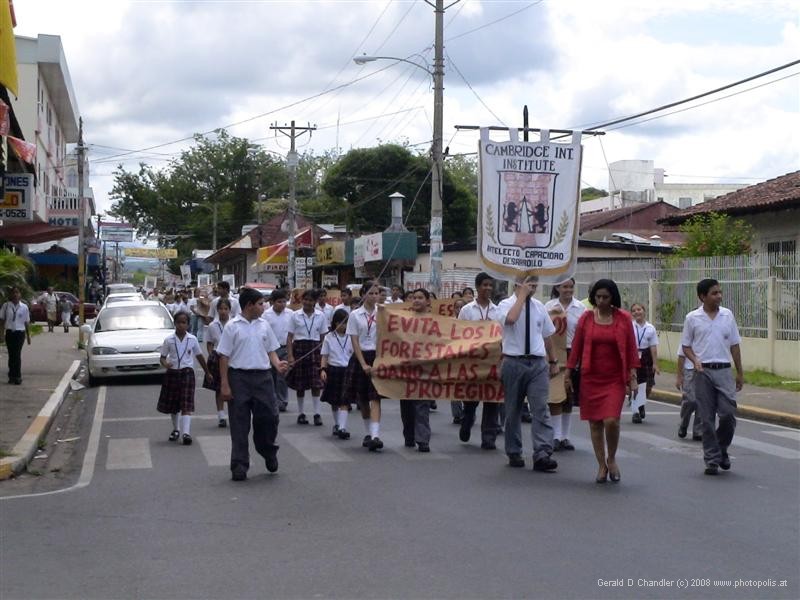
Students Marching for the Environment, David, Panama |
Our first stop was in David, the biggest city in the west of Panama, and the third in the whole country. We used LP to pick our hotel and were rather happy with the choice, even though after we had settled in we were told late that we had to change room and then the next night lost a nights sleep because we had been put over a noisy disco. In David, in fact, on the ground floor of our hotel, the Occident, we got our introduction to Panamanian cafeterias. They serve good, nutritious, and quickly boring food for $2 a meal or less. David has no major sights, so we saw none — even going to the tiny museum when it was closed. We did get our teeth cleaned and, for Jan, a new partial cap to replace one that had just fallen off. We also got our laundry done and bought car insurance; like Guatemala we'd driven a bit from the border without it.
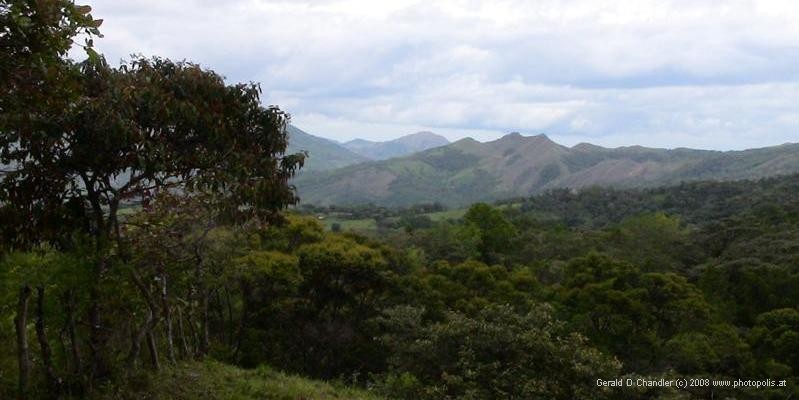
Mountain View, Boquette |
David is at sea level and thus hot. Fortunately it is only 50 km from Volcan Baru, the highest point in Panama. After four days we decamped for Boquette, a valley 1000m high nestled next to 3480m high Baru. The room, as from LP, was lovely: big, nicely furnished, and had an in-room refrigerator. Thus we had our own cold fruit and milk with breakfast, and because of kitchen privileges, had pop-corn in the evening, sometimes with chilled white wine. The weather was lovely, even though it did rain on our two-person parade on both of our hikes. The first was to the east side of town, where we got acquainted with the area as we walked along dirt roads that took us up 300 m and gave us a view of the Pacific (or so we imagined, because there were many clouds.) The next day we went west, up and then along the "Sendero Los Quetzals". Jan's legs gave out and she turned back before Gerry; he went on to the mountain pass that leads to the west side of Volcan Baru. We could have gone to the top of Baru as there is a road there; but didn't. Probably we would have gotten great views. We now regret that we didn't check out "Valle Escondido", a real estate development of an American, for Americans, and we assume, by Panamanians.

Las Lajas Beach, Panama |

Las Lajas Beach |
After our zig north to the pleasant Boquette Valley we decided we should move on. So we made a zag south to the beach at Las Lajas. We knew from Lonely Planet that the single hotel didn't offer much comfort. What we didn't know was that we wouldn't find the hotel and that the one we did find would offer even less comfort. Consequently we stayed only one night, thought the beach itself was lovely. We went away with three interesting memories: First, of the giant, 5-inch moth with four transparent holes in its wings that tired itself to death trying to find its way from the porch light. Second, of the fine fish that we had for lunch at the restaurant managed by the hotel folks, and the conversation we had with a group of 50ish missionaries from Atlanta, Georgia who were eating there after a week spent trying to convert some indigenous peoples. Third, the problem of change. Our simple room cost $10/night. Getting change for a $20 almost took another night.
Our next stop was meant to be Chitre, the base for exploration of the Azuero penisula and, if we had any luck, seeing some traditional dancing. We were about halfway there in our drive from Las Lajas when we passed through Santiago. We were looking for lunch and instead found a hotel: Gerry spotted a sign for the Hotel Gran David that said "piscina" — swimming pool. On a few seconds notice we served in, inspected the room, and stayed four days. The first two days, Thursday and Friday, were great as we had the pool nearly to ourselves. The weekend days there was a lot of pool-side partying by people who had come to the hotel for a training session. They so dirtied the pool that we wouldn't go in again.

Mountain Views near Santa Fe, Panama |
Because we had stopped in Santiago we had time to read LP in more detail and go to the IPAT (Panama Tourist Institute) office, and thus learn about Santa Fe and San Francisco. Like Boquette, Santa Fe is nestled up on the slopes of Panama's continental divide. We drove up one morning and found a place for a several hour hike along dirt roads. Early on we passed a place that is our dream homesite: such georgeous views that could not be blocked by anybody else unless the small valley, home to perhaps 500 people or less, became a Manhattan with tall towers. While there we met another Peace Corp volunteer. She pays $42/month for a two-bedroom apartment. Like all the others, she said her job is what she makes of it.

Corpus Christi Procession, San Franciso |
San Francisco is a small town 1/3 of the way from Santiago to Santa Fe. It is home to one of the oldest stone churches in Panama. Our first visit was on Saturday evening coming back from Santa Fe. Then it was closed because we were late. The next morning we went back to see the inside of the lovely stone building and its art work. Then it was closed because of repairs that have been going on two years. We did get to see a short Corpus Cristi procession that went by the stone church to the temporary one nearby.
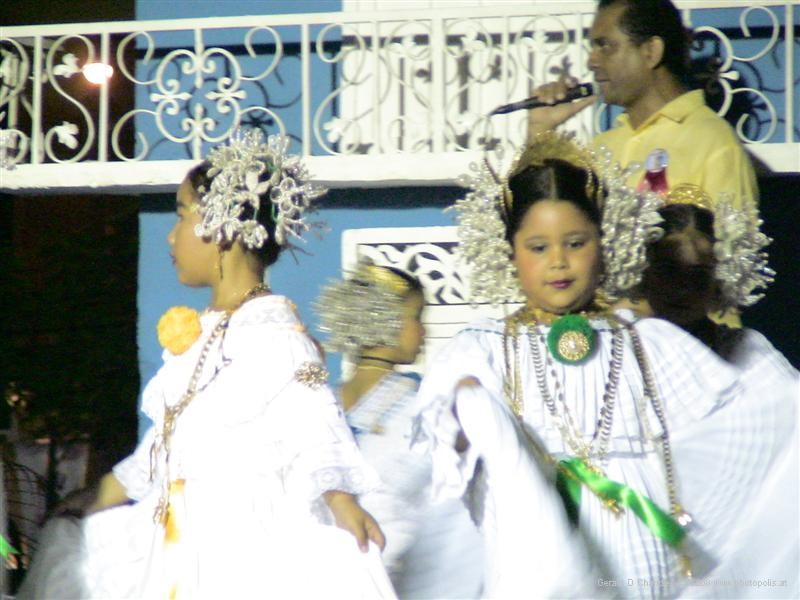
Two Chitre Girls in Pollera |
Now at last we went to Chitre. We found the Hotel Rex on the central square and stayed eight days. Of course we hadn't planned on that. But after two days we learned that the Chitre Festival of San Juan Bautisa would start in two days. And two days later we learned that the Los Santos Festival of Corpus Cristini would start in another few days. So we stayed around enjoying our spacious room — with a table even — and reading and working. We made a one day trip to the nearby beach of Monagre and another day trip farther south to Pidasi to see whales. There weren't any, but we did swim on a nice beach and meet an interesting Israeli, who introduced himself because he need change for a $10 bill.
As for the dancing, it was interesting at first, but we soon learned that every school in town and beyond got its turn; we saw the same half-dozen dances over and over. We were reminded of our attitudes in Yellowstone and Venice, so many years ago. When we saw our first moose in Yellowstone we were excited; when they walked through our campsite every day we got to wish they were gone. We had a hotel across the bay from Venice proper. Our first ferry ride in was exciting, with us peering to see the famous Dodge's palace, etc. By the third day we, like all the regulars, were reading our newspapers.
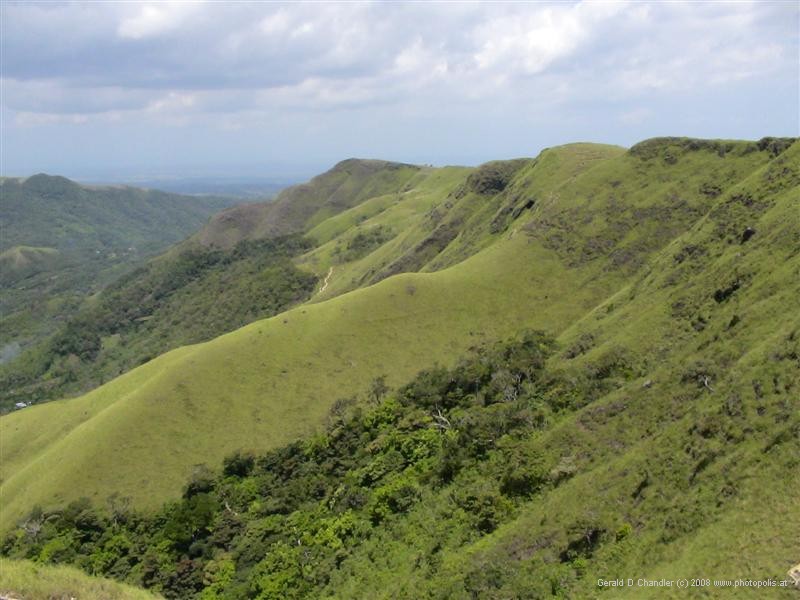
Volcan slope seen from near La India Dormida, El Valle |
All of the time we were in Chitre, Los Santos, and the Azuero penninsula we were happy to have our aircon room; when we weren't there we were always sweating. We heard that El Valle (or to give it its full name, El Valle de Anton) was at 1000 m, cooler, and a good place for greenery and hiking. Since it was about half way to Panama City we decided to head for it. Our maps did not correspond to what we were told enroute, and we never found the short route. Consequently we passed and went in to look at the all-included Playa Blanca, a definitely uppercrust beach resort. Their price was double ours and there was no budging, even though the place was empty and it was not a weekend. Too bad we didn't meet a manager with the mentality of those at Bahia Salinas and Tronadora in Costa Rica.
On we went to El Valle and got there with no difficulty as far as directions, but with a time-out to cool the car. It is located in the crater of an achient volcano, with the sides sticking up above the valley floor about 300-500 m. On our arrival we got a panoramic view that told us we came to the right spot. In town we looked for the LP-recommended Hostel El Valle. We couldn't find it so settled on the Residence El Valle, where we got a nice room with a view of Iguana Back Mt. Later we found out the Hostel El Valle had changed its name to Residence El Valle. The next day we made a walk to the waterfall, which while nice, was not worth the $3 we paid to see it. The following day we made a longer walk up to the Volcano Ridge and got to the top of La India Dormadi (Sleeping Indian) where we got wonderful views. On the way down we passed three waterfalls, all free, and all as good as the one we paid money — if not sweat — to see.
At last it was time for Panama City. The drive is easy. In fact, the Interamericana is better in Panama than anywhere else in Central America. Much of the route is already four-lanes, divided highway. In our drive from David we saw work going on to widen it to four lanes wherever they were lacking.
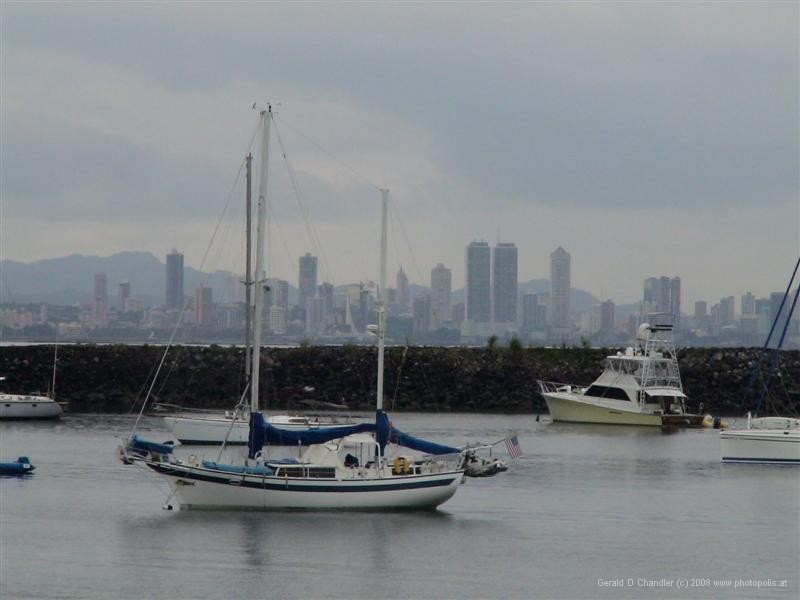
Central Panama City seen from Flamenco Yatch Club |
We came into Panama City by crossing the Puente de las Americas and thus the Panama Canal. We immediately got lost in our search for a hotel, going around the same streets three times before we realized where we were. By that time we'd seen and rejected several hotels that weren't on our original list. We then managed to find the Hotel Lisboa, which we had been searching, and we have now been resident eight days. A big plus is an open-air, olympic-sized swimming pool; we have gone three times. We have accomplished two important chores: we transfered money to our bank account — this will allow us to keep drawing at cash machines — and we got our temporary car import permit extended. We've been very lazy about sightseeing, thinking we have plenty of time. Gerry has gotten sick and that has put a few things on hold. We have managed to see the financial district, the Balboa Ave waterfront, and take a walk through the old City, Casco Viejo. More details about them later.

Olympic Size public pool across from Hotel Lisboa, Panama City |
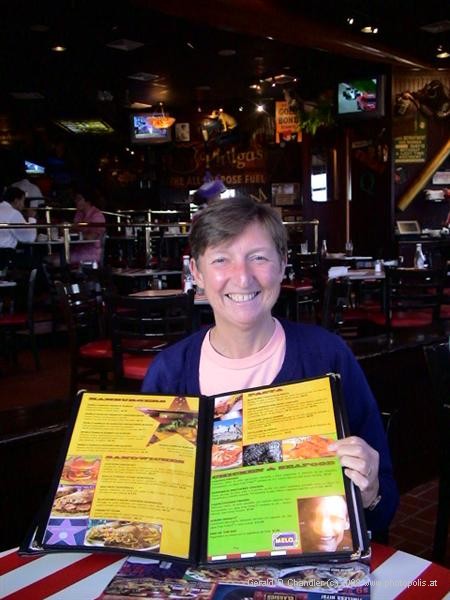
Celebrating Jan's Birthday at TGI Friday |
We eventually got around to getting well acquainted with the Panama Canal. We first went to the Miraflores Visitor Center and saw the locks and museum there. There it was to the nearby Pedro Miguel Locks where Gerry, not bored yet, watched several Panamax ships enter the locks. Jan, a bit bored and sick, sat in the car and read. Two weeks later we visited the Gatun installations, including the lock and that dam that forms Lake Gatun.
In the end we made three trips across the Isthmus and thus visited Colon three times. The first trip included just a passage through Colon, a visit to the Panama Canal Yatch Club, and then the main items of the day, a visit to old Fort San Lorenzo. The next crossing first took us to Portobelo and then another visit to Colon and the Yatch Club. Our third trip we actually saw some of Colon. There are some nice historical remnants but the place is poor and nearly all decaying.
Our stay in Panama ended with a two night stay aboard the yatch Lady Kis as we prepared to sail to Cartagena. During that time we really got to know Colon, including shopping at its market and two supermarkets. And, of course, a visit to McDonalds, twice to the internet cafe, and once at the Hong Kong restaurant.